The Cornell Lab Bird Academy › Discussion Groups › Joy of Birdwatching › Activities: Bird ID Practice
-
North suburbs of Chicago. Over the last few years I've taken to scanning the tree-tops when in the car - both as passenger and driver. This week I saw a MASSIVE bird sitting alone at the top of a pine tree in a normal suburban neighborhood next to the road. Copper/Brown in color. It took my breath away. I turned around at the next opportunity to drive by for a second look. By then it was in flight. Pretty confident it's a red-tailed hawk. Just downloaded the Merlin app, will be enjoying that too. Thanks!
-
So many red tailed hawks here in the Jersey burbs. Such a magnificent looking bird to watch either flying or up on a tree branch. One time it just remained there not at all unnerved with my family active below. He seemed to like the attention
-
-
Very active morning. In addition to the regulars I have in the yard, cardinals, finches, sparrows, doves, robins, I had a male and female rose-breasted grosbeak, a hooded warbler, a common yellow throat and 3 male Baltimore orioles. Very fun to watch.
-
I wish I had taken a picture. I have an update for Activity 3: Look for three different birds that are searching for food today. What are their food-finding behaviors? I always though cactus wrens just ate insects and seeds but I watch one killing and eating a small lizard. I verified with my Audubon ap that this is known - not common but occasionally. I can't find habits in Merlin .. although Merlin is great for ID.
-
 My favorite bird lately is the pileated woodpecker. I often see one on my daily walk on a nature trail near my home in south central Pennsylvania. While their cackling, laughing call deep in the woods lets me know they're in the vicinity, I have also learned to tune my ears to listen to the solid thumping sound they make when digging into dead trees. The one pictured here was tearing this tree apart while enjoying his breakfast. As he turned towards the sun, I saw his red mustache, identifying the bird as a male. I had to marvel at those neck muscles which bounce back and forth like they're on a spring.
My favorite bird lately is the pileated woodpecker. I often see one on my daily walk on a nature trail near my home in south central Pennsylvania. While their cackling, laughing call deep in the woods lets me know they're in the vicinity, I have also learned to tune my ears to listen to the solid thumping sound they make when digging into dead trees. The one pictured here was tearing this tree apart while enjoying his breakfast. As he turned towards the sun, I saw his red mustache, identifying the bird as a male. I had to marvel at those neck muscles which bounce back and forth like they're on a spring. -
Very cool Janice, I too am a big fan of the PWP. I wish I could see them more often but don't see too many here on Cape Cod. Enjoy!
-
-
Canada geese are common here and easy to identify by shape, so are robins
-
Activity 4 Favorite bird features: My great white egret is identified positively by its combination of a bright yellow beak and all black feet and legs. I am proud of this picture as I got the swing of the camera correct in order to capture the bird as it flew from the pond behind my house to the salt marsh 0.1 mi away behind the beach (Good Harbor) in Gloucester MA.
 In Florida there are more snowy egrets who are almost the same size but have a black beak and yellow feet. The first one below I original thought was a grgreat
In Florida there are more snowy egrets who are almost the same size but have a black beak and yellow feet. The first one below I original thought was a grgreat  white egret but think it might be a female. As with most wading birds, their feet are often hidden in the sand or water.
white egret but think it might be a female. As with most wading birds, their feet are often hidden in the sand or water. The second snowy egret picture is much more identifiable. He was waiting at a fish cleaning table for some free handouts. I am pretty sure he was showing his flume to impress a nearby great blue heron and a bunch of pelicans that he should be given more respect and maybe to the captain and mate that he should be given more fish scraps.
The second snowy egret picture is much more identifiable. He was waiting at a fish cleaning table for some free handouts. I am pretty sure he was showing his flume to impress a nearby great blue heron and a bunch of pelicans that he should be given more respect and maybe to the captain and mate that he should be given more fish scraps. -
Sensational pictures Richard.
-
-
I found three species all feeding together at a park near the Estero River behind my condo. I had often seen 2 together feeding on the same seeds but was surprised by the addition of a woodpecker which I had only seen in the trees before. Reading other peoples posts it seems they do frequent bird feeders and Merlin helped quell my previous prejudice that they were predominantly insect eaters. I am pretty sure that the prejudice developed because 95% of the time I see a woodpecker is because I hear it pecking at a tree and follow the noise. Sometimes he is making a hole for a nest but mostly digging in the tree bark or a dead tree for insects. The cardinal and blue jay are amongst the full time residents of both of my snowbird locations (northeast Massachusetts-Gloucester and SouthWest Florida (Estero) Looking at the woodpecker pictures more closely I can see the large pit of a small fruit or olive tree that is nearby.


-
ACTIVITY 3: Considering three common bird that I can see from my house: the common swift, the eurasian blackbird and the italian sparrow. The first catch insects flying in the sky all the time, the second catches insect in the ground moving leafes and the terrain, the last eats seeds and pieces of food in the ground. ACTIVITY 4: One of my favourite bird is the eurasian blackbird, Turdus Merula. The male is glossy black overall, with bright yellow bill and eyering. It's a medium-sized bird, its dimension is more or less the same as the american robin. It has a rich caroling song mostly heard at the sunrise and at the sunset.

-
A
 Bird ID Practice:
Activity 1 Shape differences. This is one of my favorite pictures and the shape differences are readily observable. The sleek smooth and slender shape of the the egret is easily differentiated from the stocker, broader body, more substantial bill and broader all over scope of the wood stork. The great blue heron in the back is intermediate between the two others. The ducks well they look like ducks out of water in this case.
Bird ID Practice:
Activity 1 Shape differences. This is one of my favorite pictures and the shape differences are readily observable. The sleek smooth and slender shape of the the egret is easily differentiated from the stocker, broader body, more substantial bill and broader all over scope of the wood stork. The great blue heron in the back is intermediate between the two others. The ducks well they look like ducks out of water in this case.

 Activity 2 Color is the color yellow. My first use of Merlin helped me ID the great crested flycatcher. He is bigger than the goldfinch (everyone knows what they look like) and this warbler. The flycatcher has four (or 5) colors (blue shoulders, black wing, yellow belly, white and rusty colored tail. I never got a good enough picture of the warbler to firmly identify it, but the size and shape and splashes or yellow pretty firmly classify it. The goldfinches are the bright spots of yellow who arrive in MA in early spring and stay until they finish eating all of my sunflowers.
Activity 2 Color is the color yellow. My first use of Merlin helped me ID the great crested flycatcher. He is bigger than the goldfinch (everyone knows what they look like) and this warbler. The flycatcher has four (or 5) colors (blue shoulders, black wing, yellow belly, white and rusty colored tail. I never got a good enough picture of the warbler to firmly identify it, but the size and shape and splashes or yellow pretty firmly classify it. The goldfinches are the bright spots of yellow who arrive in MA in early spring and stay until they finish eating all of my sunflowers. -
Where do you live? I might be able to help you ID this warbler.
-
-
Good morning, all! I'm very much a beginner and really enjoying this course. Going through it very slowly. Activity 1: I can tell the difference between a hawk, eagle and osprey by the shape of their spread out wings. Plus body shapes are different. Activity 2: I used the Merlin App to find out what kind of nuthatch I saw the other day! I determined it is a red breasted nut hatch by its black eye band. None of the other nuthatches had it. Activity 3: No luck on this activity today. I do know that ducks search for food by tipping their heads into the water. Nuthatches search for insects on trees (I think). Activity 4: One of my favourite birds is the Common Loon. Of course, its distinctive plaintive call is easy to identify. Also, it's body shape while floating on the water is distinctive to my eye. Something about the shape of its neck. It's back is what I call a checkerboard of black and white. I often spot one on a nearby lake. Then other day, one stayed near to the shore for me to watch close up for awhile. I even caught a picture of it preening upright in the water.
-
Activity 1: Swallow (I think Violet-Green, but it might have been a Tree Swallow) have a very different shape (and flight) than a house wren. The swallows dive and swoop and glide, while the wren beats his wings quickly and rhythmically. Activity 2: Rust-red-brown (rufous!). American Robins have the red breast, a Chipping Sparrow (first for me!) has a lovely rust brown cap, and a Rufous Hummingbird is pretty much rust-brown all over! Activity 3: Robins hop-scratch with two feet, and then peck the ground. Sparrows eat seeds (or bugs?) off of grass and dry flower stalks. I watched the wren for a long time but couldn't see where he was getting his food. Activity 4: The Calliope Hummingbird is one of my favorites, and I saw my first for-sure one of the season today (we also have Rufous and Anna's). Tiny, bullet-shaped body, pale green back. Light underside, tiny vertical lines of spots going down chin and breast (female). Hover-zip flying style, perched on a twig for a bit, but generally moves around a lot and very fast. Habitat is mountain meadow and thickets near streams in conifer forests.
-
Activity 2: I am trying to learn warblers and today went looking for a Prothonotary Warbler that had been seen nearby. I was looking for a yellow bird. I found singing Yellow Warblers, which are distinguished from other warblers by the orange stripes on the male's breast. There were so many that I really got to know the Yellow Warbler's song. I also found Common Yellow Throat, distinguished by their black masks. I found another yellow warbler that I thought at first was the Prothonotary, but this warbler had a black strip through it's eye. I found photos of a Blue-Winged Warbler that matched the bird I say. When I played its song, I recognized it immediately. So, it was fun to work on identifying yellow warblers today in Rhode Island. Also saw and identified a White-Eyed Vireo, which also is a small yellow bird that appears in the spring in Rhode Island.
-
I find myself using the Merlin app more and more. It is very easy to use to identify a bird. I even took a photo of what I thought were heron nests and took a picture hoping to get the bird and the nest. I was not completely successful but Merlin did identify the bird as a Blue Heron. Amazing!
-
I've got pretty good at identifying all the birds I can see from my window by sight, so I've been trying to learn their songs so I can tell which ones are around even when I can't spot them, which is getting harder now that the leaves have all grown back on the trees. When I hear a great tit close by I know they're going to show up at the feeder any second, so it's also helped me spot them more often.
-
I, too, have gotten pretty good at IDing the birds I regularly see at my feeders: Chestnut backed chickadees, Juncos, towhees, nuthatches, song sparrows, now purple finches and black capped grosbeaks. I've been practicing learning their songs, but still hear new ones in the woods I cannot identify. I understand Cornell also has a birdsong ID class, may look into that.
-
-
I have many birds feeding in the yard including house finches, sparrows, and gold finches which are feeding on seeds. I also had a Baltimore oriole feeding on an orange and a wood thrush scrapping in the leaf litter under the corneliancherry dogwoods. I like using multiple field guides for identification. I find different field guides will have some different information which will help me positively identify the bird. They also provide different pictures. I will then go on the internet to listen to their song.
-
 Eurasian blue tit (cyanistes caeruleus), Modena, Italy
Eurasian blue tit (cyanistes caeruleus), Modena, Italy

- Great tit (parus major), Modena, Italy ACTIVITY 1: Around my house I see a lot of Eurasian blue tit (cyanistes caeruleus) and Great tit (parus major). They could seem very similar at a first view and from far away. But the first is smaller, more rounded and has a shorter bill compared to the head.
-
I have been doing a lot of bird watching as a pandemic escape and the Merlin Bird ID app works fantastic. Last weekend, on my hike we spotted a lot of very different birds. Activity 1: I found a large hawk size bird and a small sparrow size bird but did not know either one. With the app's questions, I easily came to a Black-crowned Night Heron and a White-throated Sparrow. The Heron was such a find as it was sleeping in some bushes. Activity 2: I spotted several different kind of woodpeckers. All had a combination of red, black and white. I really had to work at telling the difference between a Hairy Woodpecker and a Downy Woodpecker but I do think I got it once looking at the becks. The other woodpecker I identified was the the Red-bellied Wookpecker. It is easier than the other two because their pattern is different. Activity 3: I found three different type of birds looking for food and ID them but there food foraging was very different- Great Blue Heron was fishing in the the river, the Black Rumped Warbler was moving around the top of a blooming tree and a White-Breasted Nut Hatch looking for bugs on a tree trunk. Activity 4: One of my favorite is the Baltimore Oriole. First spotting of the season, I used it color scheme-bright orange and black, its size - robinish and it's call to ID it. After doing this lesson, I tried the photo id option in Merlin. I had a picture take of the Oriole and it ID it perfectly. I would try using it. My picture quality was not the best and it still worked great.
-

 Osprey nesting and Great Blue Heron. Walking along a pond in Eagle, ID
Osprey nesting and Great Blue Heron. Walking along a pond in Eagle, ID -
For Activity 1 I watched the Bird Cam at the feeder in Sapsucker woods at Cornell lab. I used Merlin to ID a couple of the birds-but by size/shape I could right away tell apart European Starling from Black Capped Chickadee. Other birds I ID'd at the feeder using Merlin were Red winged Blackbird and Baltimore Oriole (adult female). The Bird Cams are pretty cool-they're a great feature to use especially right now! For Activity 3, I saw a mallard looking for food in the pond/wetland area in our backyard. An American Robin was pecking at the ground around the neighborhood, and I also saw a Killdeer during my run that had been on the ground and took off as I went by. The Killdeer was tricky to ID using Merlin, I didn't put in the right identifiers at first, but luckily I had seen it's back/tail as it flew away so I saw the orangey/brown color on it's rump/tail. It's shape in the air and it's call helped me confirm that's what I saw as well.
-
Hi Sarah, I id'ed Killdeer by saying, size of a robin, black, white and buff/brown, found on the ground, and that got me the Killdeer as first choice! Happy birding! Rachel
-
-
For activity 2 we went to the Iroquois National Wildlife Refuge and saw so many birds, even a Trumpeter swan (we think, as it was hard to see the bill color to be certain). But what was challenging was seeing eagles, ospreys and turkey vultures. At times it was hard to say for sure what was flying overhead due to the dark colors on all. We used the Merlin app and it did help. For activity 1 at my home feeder, I can tell the difference by the shapes because I know the birds that regularly come to my feeder, and have identified them in the past. It is more difficult to tell just by shape in the wild, it is needed to know the size also, and maybe the color or sound will help to. We saw tree swallows and sparrows and the shape of the bird and its flight was enough to help differentiate. I love learning these new ways of looking at birds in this course!!!
-
Act.1 today I saw two black birds one was a crow and one was a starling. They differed by size and shape (as well as behavior). Act3 Today I watched three birds looking for food. The cat bird was on the ground flitting in low bushes and sorting through leaves (looking for insects). The dove was also on the ground but stayed under the bird feeder looking for seeds.The cardinal flew from branch to branch in the trees and onto the bird feeder to eat seeds. Act4 I like the gold finches . They are small like a sparrow. Their coloring in the winter is an olive/brown color with darker stripes on their wings. In the late spring an summer the male is bright yellow with black wings, cap and tail. The female is more green on her back and a duller yellow on her abdomen. They like seeds and perch on flower stem and grasses to eat seeds. They live in fields, bushes and roadsides. They have an undulating flight and have a sweet, high four syllable song.
-
The Merlin app is very useful. I have been able to learn more about other species in our area that I was having trouble identifying such as the Eastern Phoebe. A couple of pairs of Eastern Phoebes are nesting nearby. Am still working on identifying some other species ... it is a great exercise.
-
Canada goose pair spotted in the neighborhood. Enjoy seeing them fly overhead.

-
I am in Yorktown, Westchester County. Activity 1: This morning on my walk, a red-tailed hawk swooped down and landed on a tree branch in front of me. It just sat there as I stood still with no camera! Right after that, a downy woodpecker came by. Definitely, two different shapes! Activity 2: Yesterday, at Croton Riverwalk, I used to Merlin to identify a pair of red-winged blackbirds and a grackle, obviously blackbirds. Activity 3: At my birdfeeder, the chipping sparrow with land on the feeder to feed. The mourning doves will feed underneath the feeder, while the robins are hopping all over my yard. Activity 4: So there is an famous eagle’s nest at FDR State Park, that can be seen off the Taconic Parkway. It has become a pandemic escape to go over to the park in the evening and watch at least one eagle perched in the trees. The nest has eaglets in it and it is a joy to watch.
-
Mary Ann, I’m in Croton... the Croton Pt Park is really good for birdwatching, lots of eagles, turkey vultures and ospreys. The Riverwalk you mentioned gets killdeer families and cormorants. MaryFM
-
-
I have found the Merlin app most helpful and oh so easy to use! I have used it numerous times. The amount of information in the app is really something. Just a little swiping and you can find the sound it makes and a map. Describe a bird; small in size, larger than a sparrow, smaller than a robin; habitat forest, eats at bird feeders, small thick orange beak, bright yellow head, belly and back, bars on the wings mostly black in color, black forehead.
Read More:
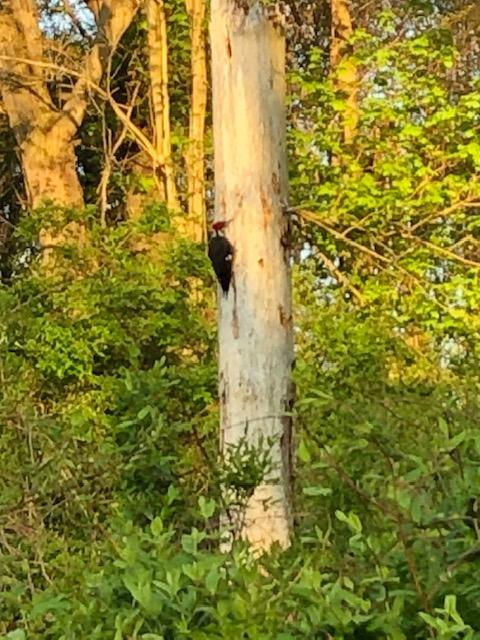 My favorite bird lately is the pileated woodpecker. I often see one on my daily walk on a nature trail near my home in south central Pennsylvania. While their cackling, laughing call deep in the woods lets me know they're in the vicinity, I have also learned to tune my ears to listen to the solid thumping sound they make when digging into dead trees. The one pictured here was tearing this tree apart while enjoying his breakfast. As he turned towards the sun, I saw his red mustache, identifying the bird as a male. I had to marvel at those neck muscles which bounce back and forth like they're on a spring.
My favorite bird lately is the pileated woodpecker. I often see one on my daily walk on a nature trail near my home in south central Pennsylvania. While their cackling, laughing call deep in the woods lets me know they're in the vicinity, I have also learned to tune my ears to listen to the solid thumping sound they make when digging into dead trees. The one pictured here was tearing this tree apart while enjoying his breakfast. As he turned towards the sun, I saw his red mustache, identifying the bird as a male. I had to marvel at those neck muscles which bounce back and forth like they're on a spring. 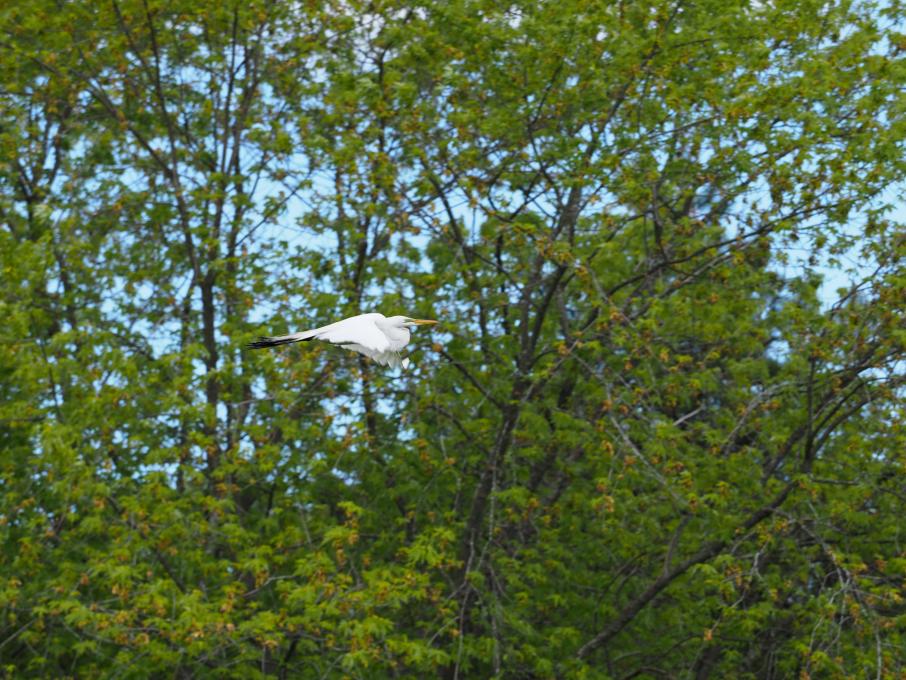 In Florida there are more snowy egrets who are almost the same size but have a black beak and yellow feet. The first one below I original thought was a grgreat
In Florida there are more snowy egrets who are almost the same size but have a black beak and yellow feet. The first one below I original thought was a grgreat 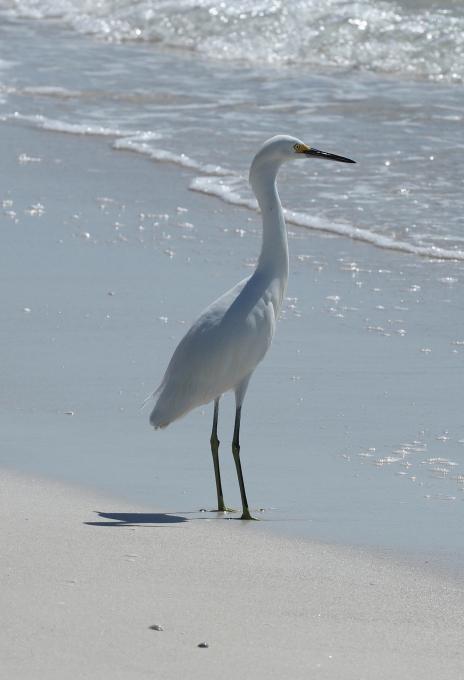 white egret but think it might be a female. As with most wading birds, their feet are often hidden in the sand or water.
white egret but think it might be a female. As with most wading birds, their feet are often hidden in the sand or water.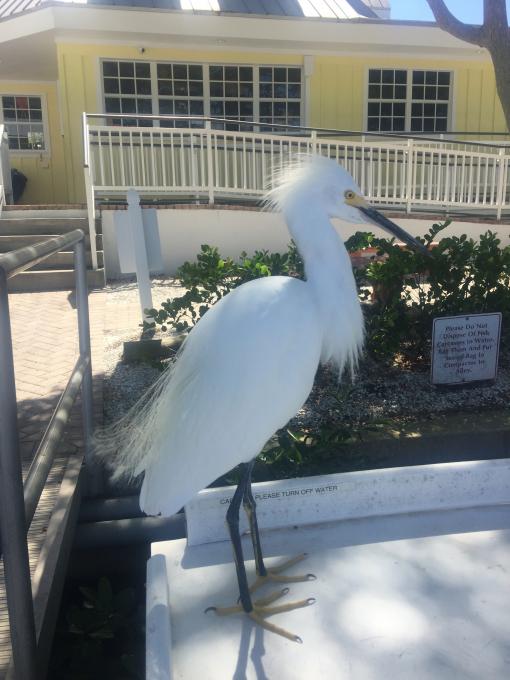 The second snowy egret picture is much more identifiable. He was waiting at a fish cleaning table for some free handouts. I am pretty sure he was showing his flume to impress a nearby great blue heron and a bunch of pelicans that he should be given more respect and maybe to the captain and mate that he should be given more fish scraps.
The second snowy egret picture is much more identifiable. He was waiting at a fish cleaning table for some free handouts. I am pretty sure he was showing his flume to impress a nearby great blue heron and a bunch of pelicans that he should be given more respect and maybe to the captain and mate that he should be given more fish scraps. 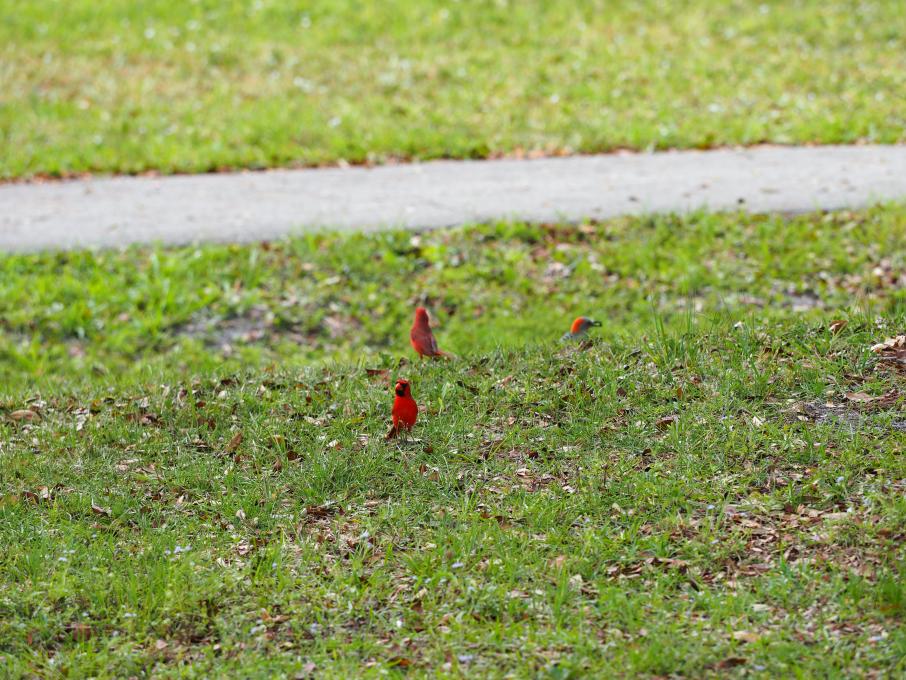
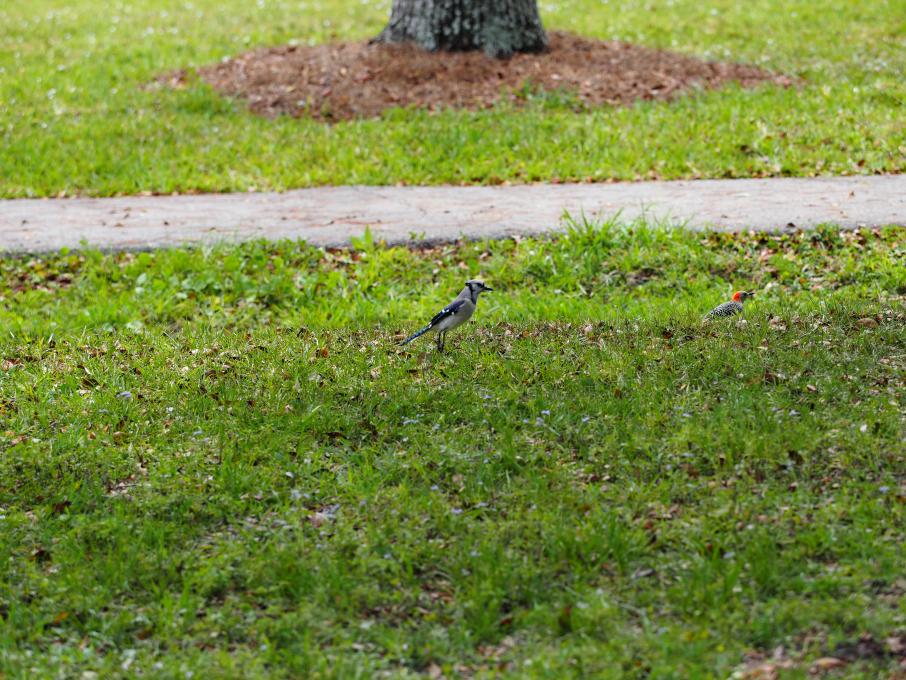
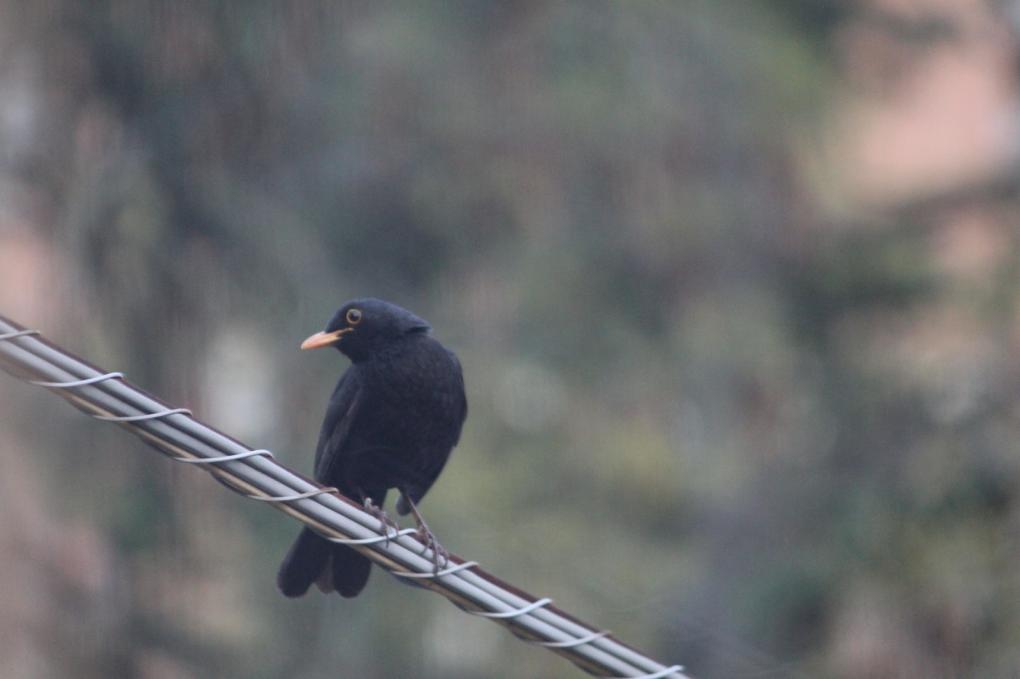
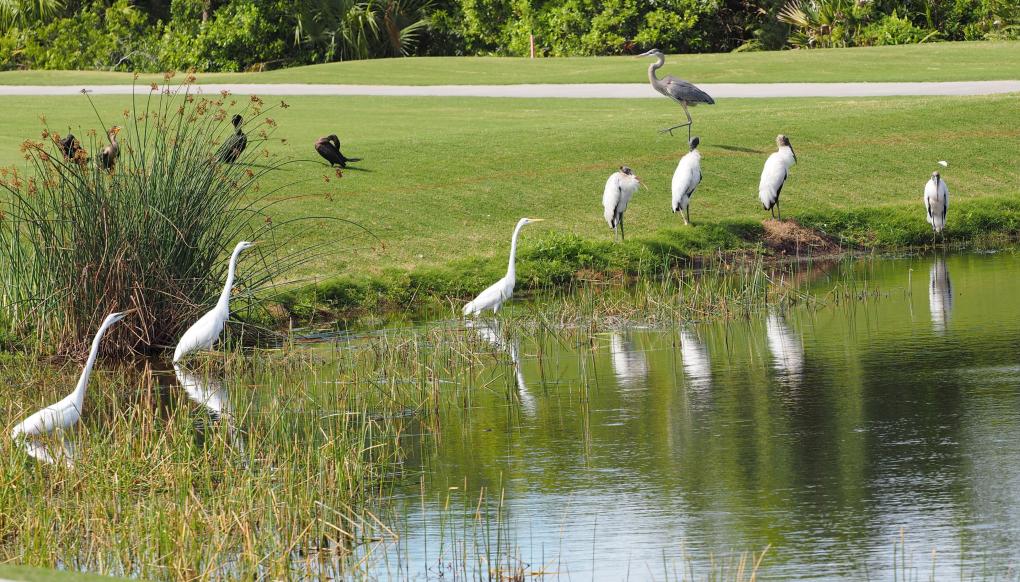 Bird ID Practice:
Activity 1 Shape differences. This is one of my favorite pictures and the shape differences are readily observable. The sleek smooth and slender shape of the the egret is easily differentiated from the stocker, broader body, more substantial bill and broader all over scope of the wood stork. The great blue heron in the back is intermediate between the two others. The ducks well they look like ducks out of water in this case.
Bird ID Practice:
Activity 1 Shape differences. This is one of my favorite pictures and the shape differences are readily observable. The sleek smooth and slender shape of the the egret is easily differentiated from the stocker, broader body, more substantial bill and broader all over scope of the wood stork. The great blue heron in the back is intermediate between the two others. The ducks well they look like ducks out of water in this case.
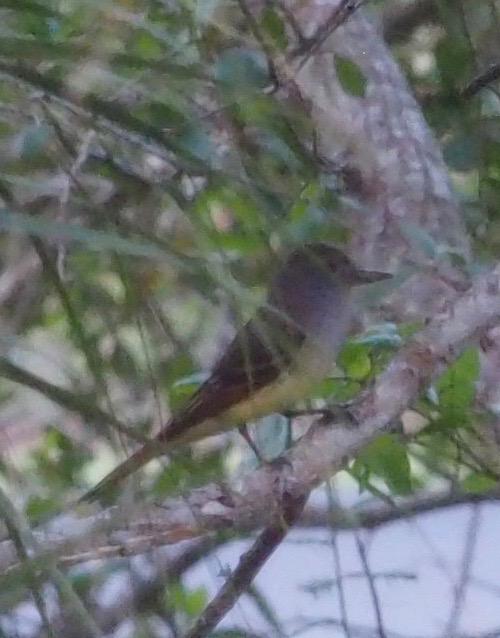
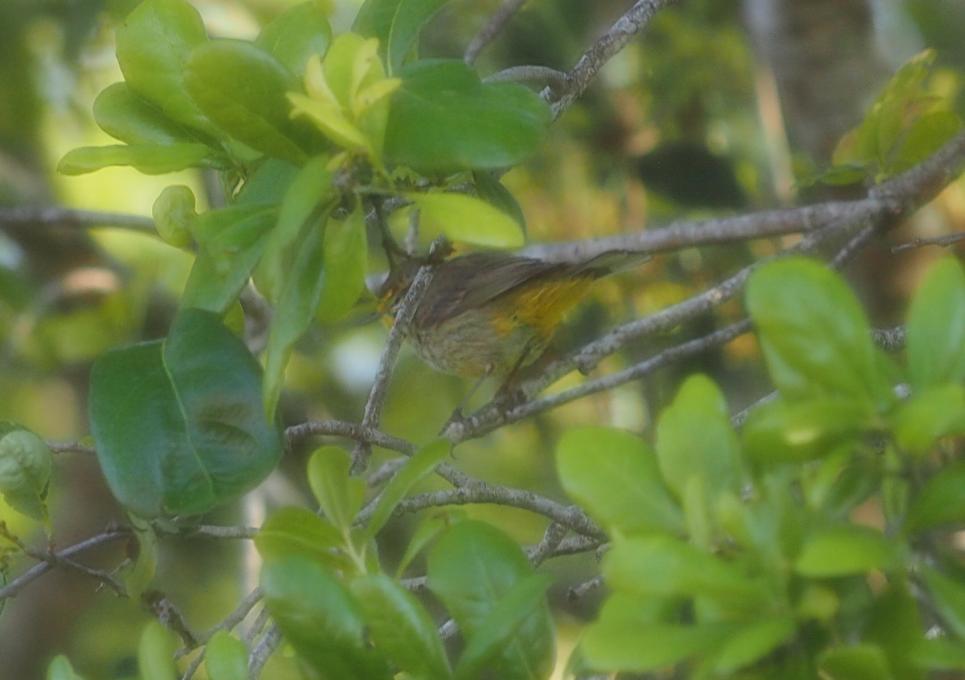 Activity 2 Color is the color yellow. My first use of Merlin helped me ID the great crested flycatcher. He is bigger than the goldfinch (everyone knows what they look like) and this warbler. The flycatcher has four (or 5) colors (blue shoulders, black wing, yellow belly, white and rusty colored tail. I never got a good enough picture of the warbler to firmly identify it, but the size and shape and splashes or yellow pretty firmly classify it. The goldfinches are the bright spots of yellow who arrive in MA in early spring and stay until they finish eating all of my sunflowers.
Activity 2 Color is the color yellow. My first use of Merlin helped me ID the great crested flycatcher. He is bigger than the goldfinch (everyone knows what they look like) and this warbler. The flycatcher has four (or 5) colors (blue shoulders, black wing, yellow belly, white and rusty colored tail. I never got a good enough picture of the warbler to firmly identify it, but the size and shape and splashes or yellow pretty firmly classify it. The goldfinches are the bright spots of yellow who arrive in MA in early spring and stay until they finish eating all of my sunflowers. 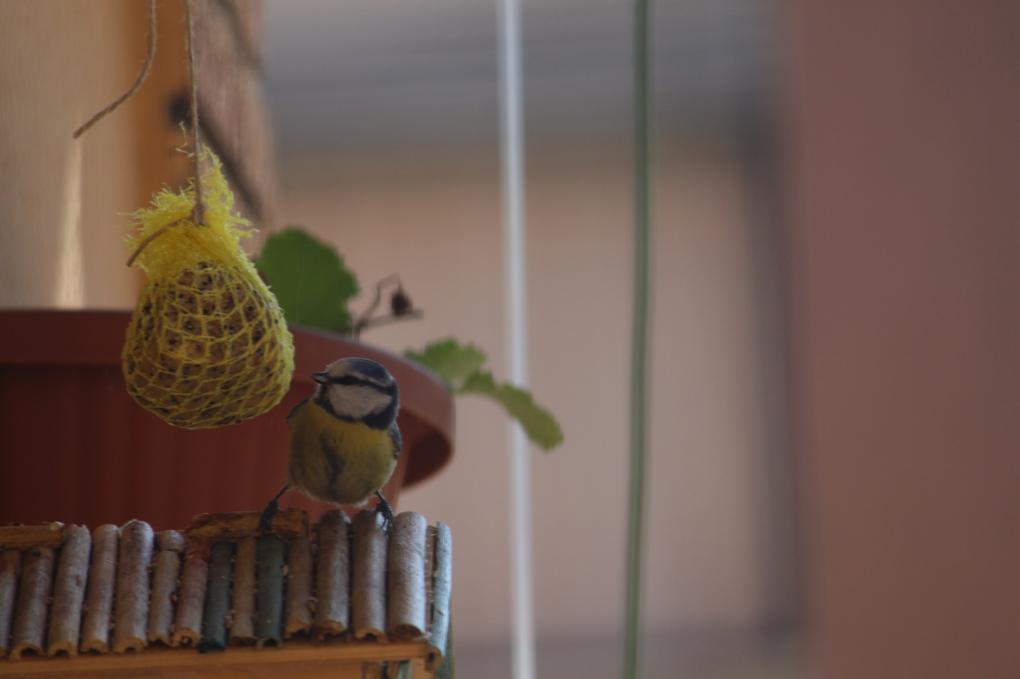 Eurasian blue tit (cyanistes caeruleus), Modena, Italy
Eurasian blue tit (cyanistes caeruleus), Modena, Italy

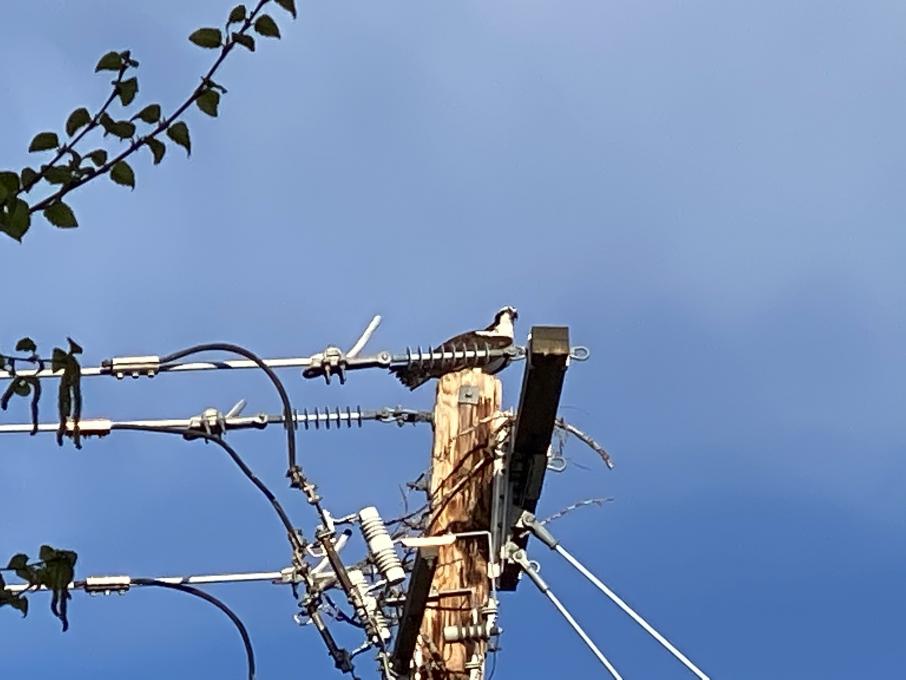
 Osprey nesting and Great Blue Heron. Walking along a pond in Eagle, ID
Osprey nesting and Great Blue Heron. Walking along a pond in Eagle, ID 